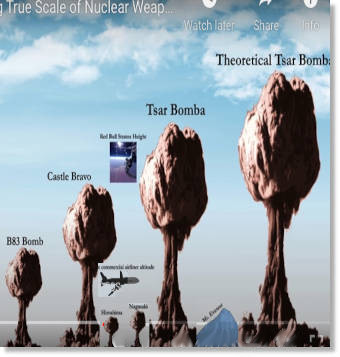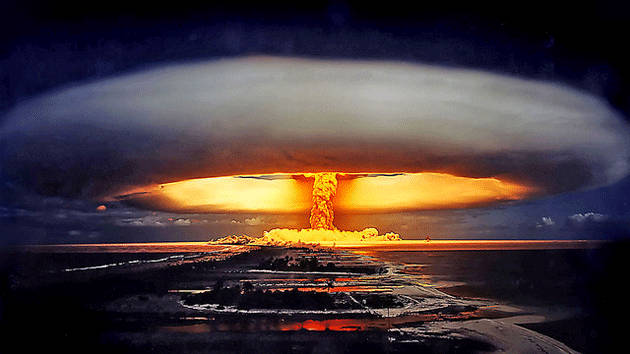
Nukes
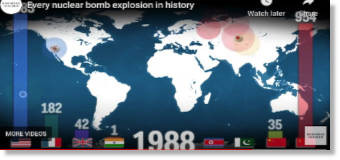 Every nuclear bomb explosion in history | 2015 | 2:32
Every nuclear bomb explosion in history | 2015 | 2:32On July 16th, 1945, the United States conducted the world's first test of a nuclear weapon. Less than a month later, two bombs were dropped on the Japanese cities of Hiroshima and Nagasaki, bringing about the end of the Second World War. No nuclear bombs have been used as weapons since the attacks on Japan, but thousands of tests have been conducted – primarily by the US and USSR throughout the Cold War.
 *The Terrifying True Scale of Nuclear Weapons |2016 | 5:56
*The Terrifying True Scale of Nuclear Weapons |2016 | 5:56Nuclear weapons have come a long way and come in all types of different sizes. Some are relatively small while others are enormous, so big they boggle the mind at what they can be capable of. This video analyzes the sizes and impacts of various different nuclear devices, the history of nuclear weapons and what countries in the world are in possession of such devices.
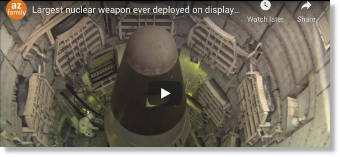 *Largest nuclear weapon ever deployed on display in Arizona | 2019 | 7:58
*Largest nuclear weapon ever deployed on display in Arizona | 2019 | 7:58They say the cold war is over, but Arizona is still holding on to at least one missile from America's nuclear arsenal. It's scary, and yet at the same time impressive. And you can see it inside the Titan Missile Museum in Sahuarita.
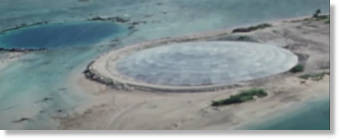 *This Concrete Dome Holds A Leaking Toxic Timebomb | Foreign Correspondent | 2017 | 41:34
*This Concrete Dome Holds A Leaking Toxic Timebomb | Foreign Correspondent | 2017 | 41:34Thousands of cubic metres of radioactive waste lies buried under a concrete dome on the Enewetak Atoll in the Marshall Islands, the legacy of over a decade of US nuclear tests in the Pacific.
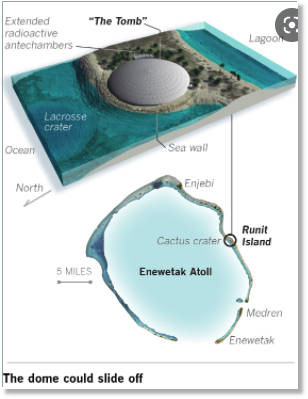
The Runit Dome, also called Cactus Dome or locally The Tomb, is a 115 m (377 ft) diameter,[2] 46 cm (18 in) thick dome of concrete at sea level, encapsulating an estimated 73,000 m3 (95,000 cu yd) of radioactive debris, including some plutonium-239. The debris stems from nuclear tests conducted in the Enewetak Atoll by the United States between 1946 and 1958.
From 1977 to 1980, loose waste and topsoil scraped off from six different islands in the Enewetak Atoll was transported here, mixed with concrete, and stored in the nuclear blast crater of the Cactus test from 6 May 1958. Four thousand US servicemen were involved in the cleanup and it took three years to complete. The waste-filled crater was finally entombed in concrete.
In 1982, a US government task force raised concern about a probable breach if a severe typhoon were to hit the island.[6] In 2013, a report by the US Department of Energy[7] found that the concrete dome had weathered with minor cracking of the structure.
However, the soil around the dome was found to be more contaminated than its contents, so a breach could not increase the radiation levels by any means. Because the cleaning operation in the 1970s only removed an estimated 0.8 percent of the total transuranic waste in the Enewetak atoll, the soil and the lagoon water surrounding the structure now contain a higher level of radioactivity than the debris of the dome itself, so even in the event of a total collapse, the radiation dose delivered to the local resident population or marine environment should not change significantly.
From 1977 to 1980, loose waste and topsoil scraped off from six different islands in the Enewetak Atoll was transported here, mixed with concrete, and stored in the nuclear blast crater of the Cactus test from 6 May 1958. Four thousand US servicemen were involved in the cleanup and it took three years to complete. The waste-filled crater was finally entombed in concrete.
In 1982, a US government task force raised concern about a probable breach if a severe typhoon were to hit the island.[6] In 2013, a report by the US Department of Energy[7] found that the concrete dome had weathered with minor cracking of the structure.
However, the soil around the dome was found to be more contaminated than its contents, so a breach could not increase the radiation levels by any means. Because the cleaning operation in the 1970s only removed an estimated 0.8 percent of the total transuranic waste in the Enewetak atoll, the soil and the lagoon water surrounding the structure now contain a higher level of radioactivity than the debris of the dome itself, so even in the event of a total collapse, the radiation dose delivered to the local resident population or marine environment should not change significantly.
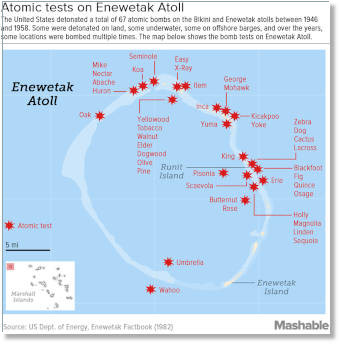
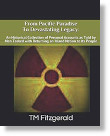 The Runit Dome, on Runit Island - Wikipedia
The Runit Dome, on Runit Island - Wikipedia
